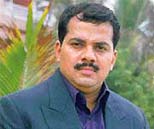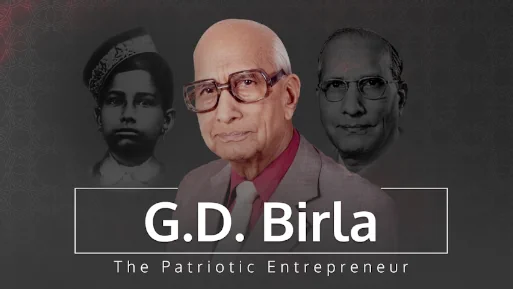The CIO of the Aditya Birla group outlines the IT strategy
09 July, 2004 | SiliconIndia Magazine
SharePradeep Shankar
 Sundarrajan has a great passion for clay modeling — intricate ones at that. In the last three decades, the man has perfected the art of sculpting the elephant-headed god of Hindu mythology, Ganesh, without using any molds. "Sculpting using clay isn't a joke. One has to start early in the morning and complete sculpting by the end of that day, before the clay dries. It's a 12 to14 hours focused effort, at the end of which you hold the product of your dexterity," says Sundarrajan, CIO of the Aditya Birla Group.
Sundarrajan has a great passion for clay modeling — intricate ones at that. In the last three decades, the man has perfected the art of sculpting the elephant-headed god of Hindu mythology, Ganesh, without using any molds. "Sculpting using clay isn't a joke. One has to start early in the morning and complete sculpting by the end of that day, before the clay dries. It's a 12 to14 hours focused effort, at the end of which you hold the product of your dexterity," says Sundarrajan, CIO of the Aditya Birla Group.
Sculpting the IT infrastructure of the $6b conglomerate of 40 companies, with 72,000 employees across 18 countries, is a slightly different ball game. Sundarrajan was handpicked from SHV Energy (prior to which he was at Hindustan Levers, (HLL) sometime in 1999 when the Aditya Birla Group's management felt the need for a CIO at the Group level. "My first task was to convince the men at the top," recalls Sundarrajan. There was no connectivity among the group companies and to realize realistic benefits, Sundarrajan started with the wide area network (WAN). His target: to connect 108 locations worldwide in the next 18 months. He studied how conglomerates like GE and Ford had carried out similar exercises, realizing however, that, "what is applicable to them may not be applicable to us. But it is definitely a guideline."
The challenge for him was twofold — one was connecting individual applications, varied mailing platforms, different domains, into one single environment and IP Addressing scheme, without disrupting the ongoing business operations, and all this at a blistering pace dictated by market and business needs. Sundarrajan and his team made sure that the migration to an integrated network happened seamlessly.
At the end of 18 months, over 150 locations were connected and at a much lesser cost than the estimated budgets. Sundarrajan not only proved his credibility to the senior management but also won the appreciation of now-connected various group companies. "There was a radical cultural change and the IT team was driven by the customers (in this case, the employees themselves) pull rather than corporate push," recollects Sundarrajan. Today more than 550 business locations are connected.
The talent pool
Like most progressive organizations, the Birla group believes that the primary asset is the expertise of its people. "Taking people along, taking a flotilla approach and leading from the front is the key." For a corporate house of the size of Aditya Birla Group, the only way of tapping the talent pool was to have a knowledge management portal of its own.
Four years ago, Sudarrajan flew to the U.S. looking for a knowledge management product that would help the group. To his surprise, there were no products that addressed the company's needs. "Most of the products those days were nothing more document management tools. Tools like discussion rooms, web chat, or expert advice columns weren't there," he recalls. Sundarrajan had no choice than to architect the solution in-house along with the HR team — the development was however outsourced. Today this knowledge management portal stands out for its scalability and low bandwidth utilization. It encompasses most of the group's employees and is co-hosted across many of the group's business locations.
Being a large diversified group, the need to empower its people assets has driven it to embark on an e-learning initiative providing over 2000 courses such as marketing strategy, managing time, strategy management, dynamic decision-making, and Cisco certification. While the group had a Management Development Institute, the IT based training provided employees the flexibility of time to learn, and choice of courses. "Today the Group holds the World record for e-learning course completion rate, which stands at 90 percent plus. The earlier World record was 65 percent," explains Sundarrajan, "what is surprising is the success of e-learning in a traditional manufacturing environment."
The centralisation
Once an integrated network was in place, Sundarrajan looked at other parts of the infrastructure that could be centralised — bringing increased efficiency. Instead of every business having its own data centers, he believed that it would make more business sense to have a centralized data center. His new target was to deploy 35 servers in 18 months. Today almost all the transactions of all the group companies happen on the 55+ servers co-hosted at the Ahura data center in Mumbai. Once an integrated network and centralized data center was in place it became easier for the group to expand rapidly.
If today Birla Sun Life, one of the group companies, decides to open an office in Varanasi, the business can be up and running — the office can seamlessly connect to the Ahura data center and run its business applications, even if the infrastructure is not in place.
It is not only the quick connectivity that makes the Birla Group's network remarkable, but also the promise of a 100 percent availability and reliability. If the leased line connecting its Ahmedabad or Pune office is down, the link can be established in no time through VSAT, VPN or dialup connectivity. By centralizing the data centers the Birla Group has been able to save cost. "Four years back we had 160 processing centers. Today we have 59. Our target is to get to 15," says the ambitious CIO.
Independent control
Sundarrajan knows that centralization is not possible everywhere. So IT heads of individual business units are allowed to make independent decisions on the software packages they want to procure and deploy. However, they will have to adhere to the policy guidelines of the group, which illustrates the choice of products, technology options and vendors so that the local construction is as per the group's overall information architecture.
Some of the group companies still have in-house ERPs. Sundarrajan doesn't see anything wrong in them as long as they meet the business needs. He is, however making sure that their architecture is right so that, as the IT vision unfolds, relevant information is available at all levels across the group in real-time. The architecture is flexible so that new applications such as
e-procurement, e-learning, and financial consolidation are easily plugged and run.
Every six months all the 30 IT heads of different group companies get together to discuss the Group's IT roadmap. As captain, Sundarrajan ensures that even seemingly unimportant issues are addressed, conflicts are resolved and needs are met. If there is a specific project, say an ERP implementation in one of the businesses, ERP experts from other group companies are roped in for any assistance. "As they say, God lies in details," he remarks.
Sundarrajan's team of 10 experts at the corporate level along with 240 IT professionals at various group companies form the driving force of Aditya Birla Group's IT initiatives. "Budget comparison is not right. Any IT investment has tangible and intangible benefits. To look at budgets as a percentage of gross turnover is wrong; IT solutions need to be looked at as business solutions. Business requirement should speak up for technology rather than technologist. As long as there is a business need, budget will always be available," says Sundarrajan.
By consolidating the network across group companies and centralizing data centers, Sudarrajan has demonstrated that the right architecture is the key to higher productivity. In optimizing the conceptual architecture, the Aditya Birla Group has been able to cut down on IT costs substantially.
The road ahead
As the IT infrastructure has enabled the group companies to consolidate and spread the IT culture, the future focus is on putting business applications in place and digitizing most of the business processes. With this, demand for storage is bound to increase. The group foresees that a couple of years on, nearly one terra byte of data would be transacted each day in each of its business. "And this will grow exponentially. Storage solutions and business applications are key areas we are focusing at present. The next few years will be more challenging than it was in the past," says Sundarrajan.
Storage and business application, however, are not his only concern. He wants to go a step ahead and explore the possibility of cross-selling products with the same customer base. For instance the group's fertilizer product customers can be tapped by the group's cement business and vice versa. "By having the right architecture in place one can reap enormous benefits," he says, speaking from his past experiences.
For Sundarrajan, heading the IT function of a large conglomerate is akin to playing a role of an infrastructure and information architect. As a young lad, his dream had been to become an architect. He wryly notes that he married an architect. "Today, I can tell her that even I am an architect, but of a different kind."






